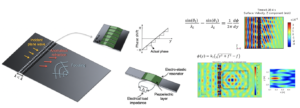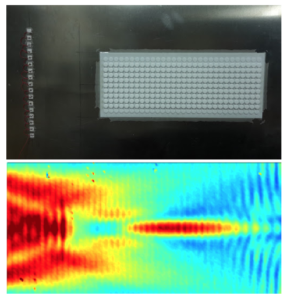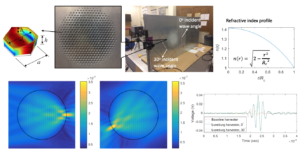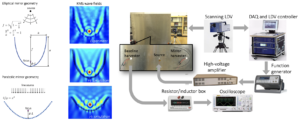- In-Space Design Technologies Integrated with Novel Metamaterials
- Topological Metamaterials
- Subwavelength Imaging via Negative Refraction-Based Super Lenses
- Conformal Gradient-Index Lenses for Ultrasonic Wave Amplification and Improved Diagnostics
- Reconfigurable Metasurfaces for Controlling Elastic Wavefront
- Metamaterial Lens Concepts for Enhanced Energy Harvesting
- Elastic Mirror Concepts for Wave Focusing
- Structure-Borne Elastic Wave Energy Harvesting
Conformal Gradient-Index Lenses for Ultrasonic Wave Amplification and Improved Diagnostics
(NSF Grant Number CMMI 1914583/1914663, Project date: 06/15/2019 – 05/31/2023)
Current structural systems are made of homogenous materials such as cast iron, wrought iron, bare steel and brittle plastic, which are highly susceptible to failure and therefore they require accelerated inspection and repair. Ultrasonics is based on propagating elastic waves in structures, which are affected by heterogeneities and defects, and used for the damage diagnostics. However, in conventional structures, the amplitude of elastic waves decays with distance due to spreading/scattering, which limits the detectability of critical defects. In this research, new structural systems will be designed with the embedded or externally added lens such that ultrasonic signal can be focused and amplified as it propagates in the structure. Hence, ultrasonic wave energy can be transmitted and preserved over long distances. In this collaborative research (with Prof. Didem Ozevin at UIC – Civil and Materials Engineering) we aim to detect defects at their earliest stage and prevent unexpected failures.

This research introduces a conformal gradient-index (GRIN) metamaterial lens as part of a structural system such that the wave is amplified as it propagates through the non-planar structure. With the GRIN lens, different ultrasonic wave modes (longitudinal, flexural, or torsional) will be focused and transmitted such that higher frequencies (50 kHz – 200 kHz) will be able to propagate with the increased sensitivity to structural damage. GRIN lens will be designed by varying the refractive index of unit cells and the existing model of GRIN lens for flat surfaces will be modified for conformal surfaces. The metamaterial lens layer will be created with 3D printing, which would allow more practical and light weight structures easily integrated with the host structure. Additionally, novel composite pipe structure with multi-material additive manufacturing technologies will be designed with the embedded metamaterial lens to address the highest risk to cause major incidents of conventional materials used in pipelines.
Reconfigurable Metasurfaces for Controlling Elastic Wavefront
(NSF Grant Number CMMI 1933436, Project date: 09/01/2019 – 08/31/2023)

While metamaterials/Phononic crystal (PC) structures are proven to be useful in many ultrasonic applications, their wave functionality is limited in the low frequency regime due to the low transmission efficiency of the metamaterials and large space needs of the PC structures. Since most of the energy is carried by low frequency waves propagating in mechanical or civil systems, it is crucial to develop compact structures enabling broadband control of low frequency elastic waves without the need for further structural modification. This research deals with effectively tailoring elastic waves (in the sub-kHz range) within a small footprint and will advance the state-of-art with the active and nonlinear metasurface concepts. In this research, our goal is to manipulate and control low frequency elastic waves in a broadband fashion via reconfigurable metasurfaces. The key idea is to leverage the linear/nonlinear dynamics of the elastic/electro-elastic unit cells in the design of the metasurface and shape the elastic wavefront by tuning the dynamic properties of individual unit cells under external applied electrical or mechanical load. Hence, the reconfigurable metasurface will be adapted to environment conditions and achieve more dynamic wave functionalities such as steering and focusing in a broadband frequency range.
Overall, we seek to create next-generation metasurfaces to modulate elastic wavefront toward high impact applications in mechanical, civil and aerospace systems. For instance, the reconfigurable metasurface will enable broadband wave focusing and highly efficient energy harvesters converting low frequency vibrations into usable electricity. We have so far established a theoretical framework to implement the required phase gradient for achieving desired dynamic wavefront shape. Our theoretical results for the passive metasurface is capable of six-fold increase in the velocity amplitude which will translate into a dramatic increase (~36 times) in the harvester efficiency.
Metamaterial Lens Concepts for Enhanced Energy Harvesting

This research deals with the enhancement of structure-borne elastic wave energy harvesting, both numerically and experimentally, by exploiting Gradient-Index Phononic Crystal Lens (GRIN-PCL) structures. The first GRIN-PCL is formed by an array of blind holes with different diameters on an aluminum plate, where the blind hole distribution is tailored to obtain a hyperbolic secant gradient profile of refractive index guided by finite-element simulations of the lowest asymmetric mode Lamb wave band diagrams. Under plane wave excitation from a line source, experimentally measured wave field validates the numerical simulation of wave focusing within the GRIN-PCL domain. A piezoelectric energy harvester disk located at the first focus of the GRIN-PCL yields 13.8 times power output as compared to the baseline case of energy harvesting without the GRIN-PCL on the uniform plate counterpart.
More recently, a 3D printed GRIN-PCL has been proposed and experimentally validated to localize elastic wave energy for enhanced energy harvesting. The concept could be further implemented for integrated harvester systems.
While the GRIN-PC lens is a very effective design implemented to focus propagating flexural waves (A0 mode Lamb wave) for enhanced piezoelectric energy harvesting, its performance is susceptible to the orientation of the incident plane wave. In order to alleviate the directivity issue, a PC Luneburg lens capable of omnidirectional focusing is designed and fabricated. The proposed lens is formed using hexagonal unit cells with blind holes of different diameters, which are determined according to the Luneburg lens refractive index distribution. Wave simulations are performed numerically under plane wave excitation from a line source for different angles of incidence, and omnidirectional focusing is observed at the opposite border of the lens with respect to the incident wave direction. With piezoelectric energy harvesters located at the boundary of the phononic crystal Luneburg lens, more than an order of magnitude larger power output (~13 times) can be extracted as compared to the baseline case of energy harvesting without the lens under the same plane wave excitation.
These innovative methods of localization of the wave energy aims to increase the efficiency of the small sized harvesters and allow energy harvesting to become a source of power for portable electronics and wireless sensors. Beyond enhanced energy harvesting, ramifications of this work range from MEMS implementation to 3D printed platforms for structural integration in sensing applications and nondestructive testing.
Structurally Embedded Mirror Configurations for Elastic Wave Focusing
The harvesting of elastic waves propagating in structures can be enhanced dramatically via spatial focusing using mirror and lens concepts. Initially, heuristically designed elastic mirror designs are composed of bulky cylindrical attachments served as effective reflectors while drastically altering thin host structures. Enabling structurally embedded mirror (SEM) configurations that avoid substantial modification of the host system requires a thorough understanding of the elastic mirror dynamics. This research presents a detailed investigation of SEM design, analysis, and experimental validation for enhanced elastic wave energy harvesting, among other applications that can benefit from spatially focused wave intensity. The SEM concept proposed in this effort uses metallic spheres (e.g., tungsten, lead, and steel) inserted into blind holes in a flat aluminum plate domain. The results show that, while SEM performance improves with property mismatch between the inclusion and the host materials, transmission resonances of the inclusions are detrimental to reflection performance and have to be avoided. A relationship between elastic mirror geometry and wavelength is unveiled to minimize the energy concentration in the side lobes around the intended focus, enabling small-sized and simple harvester design. These basic concepts and principles, demonstrated through finite-element simulations, are validated experimentally over a range of frequencies. Dramatic enhancement of the harvested power (by an order of magnitude) is also demonstrated using an elliptical SEM made from spherical tungsten inclusions in an aluminum plate.
Structure-Borne Elastic Wave Energy Harvesting

This research is centered on electricity generation from waves propagating in elastic structures with an ultimate goal to power small electronic components. By eliminating the need for batteries or power supplies, next-generation self-powered wireless electronic components can be enabled in various engineering systems ranging from structural health monitoring sensors to medical implants (*IoT image from Wikipedia). Vibration-based energy harvesters such as base-excited cantilevers with piezoelectric laminates have been well studied with both linear and nonlinear models to exploit the vibrational energy at a fixed position in space. During her PhD research at Georgia Tech, Prof. Tol proposed a wave propagation approach to energy harvesting and contributed to literature with new insights that are not evident in vibration-based approaches. She developed analytical electromechanical models for elastic wave harvesting propagating in a one-dimensional setting (i.e. beams) via piezoelectric transduction. Using these fully coupled models, it is possible to identify the interaction between the traveling waves and the piezoelectric harvester in different scenarios and determine the optimal parameters (size, electrical load, etc.) for the harvester in order to exploit the maximum of the available elastic wave energy. Theoretical framework developed in this research was successfully validated with experiments performed on various configurations of piezoelectric harvesters. Furthermore, using lumped obstacles in the transmission domain revealed that energy harvesting performance can be further enhanced, up to ~90% theoretical efficiency levels (with no losses in the system). This observation was then extended in two-dimensional setting (i.e. plates) with elastic mirrors in the form of elliptic or parabolic reflector designs.




